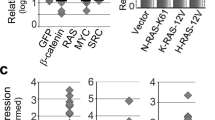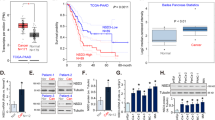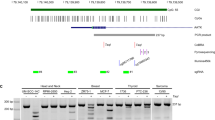Abstract
The persistent activation of signaling cascades results in dramatic consequences that include loss of cellular growth control and neoplastic transformation. We show here that phosphoinositide 3-kinase (PI 3-kinase) and its mediator Akt were constitutively activated in pancreatic cancer and that this might be due to the aberrant expression of their natural antagonist MMAC/PTEN. Indeed, our results show that MMAC/PTEN expression was either lost or significantly reduced in five of eight cell lines and in twelve of seventeen tumor specimens examined. That the poor expression of MMAC/PTEN in pancreatic cancer cells could be due to promoter methylation was indicated by methylation-specific PCR analysis. Our studies also indicated that PI 3-kinase targeted two important transcription factors in pancreatic cancer cells. The ability of constitutively activated NF-κB to induce gene expression and the stabilization of c-MYC protein by decreased phosphorylation of Thr58 were both dependent on PI 3-kinase activity. When pancreatic cancer cells were treated with a peptide antagonist of NF-κB nuclear translocation, or stably transfected with a dominant-negative mutant of MYC, their proliferation was markedly inhibited. Taken together, these data indicate that the aberrant expression of MMAC/PTEN contributes to the activation of the PI 3-kinase/Akt pathway and its transcription factor mediators in pancreatic cancer.
This is a preview of subscription content, access via your institution
Access options
Subscribe to this journal
Receive 50 print issues and online access
$259.00 per year
only $5.18 per issue
Buy this article
- Purchase on Springer Link
- Instant access to full article PDF
Prices may be subject to local taxes which are calculated during checkout






Similar content being viewed by others
References
Adsay NV, Dergham ST, Koppitch FC, Dugan MC, Mohamed AN, Vaitkevicius VK and Sarkar FH . (1999). Pancreas, 18, 111–116.
Arlt A, Gehrz A, Muerkoster S, Vorndamm J, Kruse ML, Folsch UR and Schafer H . (2003). Oncogene, 22, 3243–3251.
Bondar VM, Sweeney-Gotsch B, Andreeff M, Mills GB and McConkey DJ . (2002). Mol. Cancer Ther., 1, 989–997.
Campbell SL, Khosravi-Far R, Rossman KL, Clark GJ and Der CJ . (1998). Oncogene, 17, 1395–1413.
Cantley LC and Neel BG . (1999). Proc. Natl. Acad. Sci. USA, 96, 4240–4245.
Chan TO, Rittenhouse SE and Tsichlis PN . (1999). Annu. Rev. Biochem., 68, 965–1014.
Chang HW, Aoki M, Fruman D, Auger KR, Bellacosa A, Tsichlis PN, Cantley LC, Roberts TM and Vogt PK . (1997). Science, 276, 1848–1850.
Cheng JQ, Ruggeri B, Klein WM, Sonoda G, Altomare DA, Watson DK and Testa JR . (1996). Proc. Natl. Acad. Sci. USA, 93, 3636–3641.
Dang CV, Resar LM, Emison E, Kim S, Li Q, Prescott JE, Wonsey D and Zeller K . (1999). Exp. Cell Res., 253, 63–77.
Davies MA, Lu Y, Sano T, Fang X, Tang P, LaPushin R, Koul D, Bookstein R, Stokoe D, Yung WK, Mills GB and Steck PA . (1998). Cancer Res., 58, 5285–5290.
Di Cristofano A and Pandolfi PP . (2000). Cell, 100, 387–390.
Ebert MP, Fei G, Schandl L, Mawrin C, Dietzmann K, Herrera P, Friess H, Gress TM and Malfertheiner P . (2002). Br. J. Cancer, 86, 257–262.
Evans DB, Lee JE, Pisters PW, Charnsangavej C, Ellis LM, Chiao PJ, Lenzi R and Abbruzzese JL . (1997). Cancer Treat. Res., 90, 109–125.
Fahy BN, Schlieman M, Virudachalam S and Bold RJ . (2003). Br. J. Cancer, 89, 391–397.
Friess H, Kleeff J, Korc M and Buchler MW . (1999). Digest. Surg., 16, 281–290.
Ghosh AK, Grigorieva I, Steele R, Hoover RG and Ray RB . (1999). Gene, 235, 85–91.
Grewe M, Gansauge F, Schmid RM, Adler G and Seufferlein T . (1999). Cancer Res., 59, 3581–3587.
Grumont RJ, Strasser A and Gerondakis S . (2002). Mol. Cell, 10, 1283–1294.
Hilgers W and Kern SE . (1999). Genes Chromosomes Cancer, 26, 1–12.
James L and Eisenman RN . (2002). Proc. Natl. Acad. Sci. USA, 99, 10429–10434.
Kolenko V, Bloom T, Rayman P, Bukowski R, Hsi E and Finke J . (1999). J. Immunol., 163, 590–598.
Koul D, Yao Y, Abbruzzese JL, Yung WK and Reddy SA . (2001). J. Biol. Chem., 276, 11402–11408.
Li J, Yen C, Liaw D, Podsypanina K, Bose S, Wang SI, Puc J, Miliaresis C, Rodgers L, McCombie R, Bigner SH, Giovanella BC, Ittmann M, Tycko B, Hibshoosh H, Wigler MH and Parsons R . (1997). Science, 275, 1943–1947.
Lillemoe KD . (1995). Ann. Surg., 221, 133–148.
Longnecker DS . (1999). Ann. NY Acad. Sci., 880, 74–82.
Maehama T and Dixon JE . (1998). J. Biol. Chem., 273, 13375–13378.
Maira S-M, Galetic I, Brazil DP, Kaech S, Ingley E, Thelen M and Hemmings BA . (2001). Science, 294, 374–380.
Mills GB, Lu Y and Kohn EC . (2001). Proc. Natl. Acad. Sci. USA, 98, 10031–10033.
Mutter GL, Lin MC, Fitzgerald JT, Kum JB, Baak JP, Lees JA, Weng LP and Eng C . (2000). J. Natl. Cancer Inst., 92, 924–930.
Nagy A, Kozma L, Kiss I, Ember I, Takacs I, Hajdu J and Farid NR . (2001). Anticancer Res., 21, 1321–1325.
Ng SS, Tsao MS, Nicklee T and Hedley DW . (2001). Clin. Cancer Res., 7, 3269–3275.
Ng SSW, Tsao MS, Chow S and Hedley DW . (2000). Cancer Res., 60, 5451–5455.
Okami K, Wu L, Riggins G, Cairns P, Goggins M, Evron E, Halachmi N, Ahrendt SA, Reed AL, Hilgers W, Kern SE, Koch WM, Sidransky D and Jen J . (1998). Cancer Res., 58, 509–511.
Perugini RA, McDade TP, Vittimberga Jr FJ and Callery MP . (2000). J. Surg. Res., 90, 39–44.
Podsypanina K, Ellenson LH, Nemes A, Gu J, Tamura M, Yamada KM, Cordon-Cardo C, Catoretti G, Fisher PE and Parsons R . (1999). Proc. Natl. Acad. Sci. USA, 96, 1563–1568.
Reddy SA . (2001). Cancer J., 7, 274–286.
Reddy SA, Huang JH and Liao WS . (1997). J. Biol. Chem., 272, 29167–29173.
Reddy SA, Huang JH and Liao WS . (2000). J. Immunol., 164, 1355–1363.
Rodriguez-Viciana P, Warne PH, Dhand R, Vanhaesebroeck B, Gout I, Fry MJ, Waterfield MD and Downward J . (1994). Nature, 370, 527–532.
Sakurada A, Suzuki A, Sato M, Yamakawa H, Orikasa K, Uyeno S, Ono T, Ohuchi N, Fujimura S and Horii A . (1997). Jpn. J. Cancer Res., 88, 1025–1028.
Salvesen HB, MacDonald N, Ryan A, Jacobs IJ, Lynch ED, Akslen LA and Das S . (2001). Int. J. Cancer, 91, 22–26.
Schleger C, Verbeke C, Hildenbrand R, Zentgraf H and Bleyl U . (2002). Modods Pathol., 15, 462–469.
Sears R, Nuckolls F, Haura E, Taya Y, Tamai K and Nevins JR . (2000). Genes Dev., 14, 2501–2514.
Shah SA, Potter MW, Hedeshian MH, Kim RD, Chari RS and Callery MP . (2001). J. Gastrointest. Surg., 5, 603–612 discussion 612–6133.
Shi Q, Le X, Abbruzzese JL, Peng Z, Qian CN, Tang H, Xiong Q, Wang B, Li XC and Xie K . (2001). Cancer Res., 61, 4143–4154.
Shields JM, Pruitt K, McFall A, Shaub A and Der CJ . (2000). Trends Cell Biol., 10, 147–154.
Sizemore N, Leung S and Stark GR . (1999). Mol. Cell. Biol., 19, 4798–4805.
Staal SP, Hartley JW and Rowe WP . (1977). Proc. Natl. Acad. Sci. USA, 74, 3065–3067.
Steck PA, Pershouse MA, Jasser SA, Yung WK, Lin H, Ligon AH, Langford LA, Baumgard ML, Hattier T, Davis T, Frye C, Hu R, Swedlund B, Teng DH and Tavtigian SV . (1997). Nat. Genet., 15, 356–362.
Tanno S, Mitsuuchi Y, Altomare DA, Xiao GH and Testa JR . (2001). Cancer Res., 61, 589–593.
van Weeren PC, de Bruyn KM, de Vries-Smits AM, van Lint J and Burgering BM . (1998). J. Biol. Chem., 273, 13150–13156.
Vanhaesebroeck B and Alessi DR . (2000). Biochem. J., 346 (Part 3), 561–576.
Wang W, Abbruzzese JL, Evans DB, Larry L, Cleary KR and Chiao PJ . (1999). Clin. Cancer Res., 5, 119–127.
Whang YE, Wu X, Suzuki H, Reiter RE, Tran C, Vessella RL, Said JW, Isaacs WB and Sawyers CL . (1998). Proc. Natl. Acad. Sci. USA, 95, 5246–5250.
Wu Y, Dowbenko D, Spencer S, Laura R, Lee J, Gu Q and Lasky LA . (2000). J. Biol. Chem., 275, 21477–21485.
Yao Z, Okabayashi Y, Yutsudo Y, Kitamura T, Ogawa W and Kasuga M . (2002). Pancreas, 24, 42–46.
Acknowledgements
We gratefully acknowledge Drs Peter Sabbatini, Boudewijn Burgering and Dimpy Koul for the Akt constructs used in this study, Drs Robert N Eisenman, René Bernards, Masato Kasuga and Anke Klippel for M4-luciferase reporter, pCMV-MADMYC, p85DN and p110KR, respectively. We also thank Drs Michael A Davies and Dimpy Koul for their assistance with the viral infection experiments, Drs Paul Chiao and Douglas Evans for the pancreatic adenocarcinoma specimens and Walter Pagel for reading the manuscript. This work was supported by a grant (to SAR) from the Lustgarten Foundation for Pancreatic Cancer Research and by funds from the University Cancer Foundation (to SAR) at the University of Texas MD Anderson Cancer Center. We received valuable assistance from the DNA sequencing and Media preparation facilities at the University of Texas MD Anderson Cancer Center, which are supported by a grant from the National Cancer Institute (CA016672).
Author information
Authors and Affiliations
Corresponding author
Rights and permissions
About this article
Cite this article
Asano, T., Yao, Y., Zhu, J. et al. The PI 3-kinase/Akt signaling pathway is activated due to aberrant Pten expression and targets transcription factors NF-κB and c-Myc in pancreatic cancer cells. Oncogene 23, 8571–8580 (2004). https://doi.org/10.1038/sj.onc.1207902
Received:
Revised:
Accepted:
Published:
Issue Date:
DOI: https://doi.org/10.1038/sj.onc.1207902
Keywords
This article is cited by
-
Novel PIKfyve/Tubulin Dual-target Inhibitor as a Promising Therapeutic Strategy for B-cell Acute Lymphoblastic Leukemia
Current Medical Science (2024)
-
circACTR2 attenuates gemcitabine chemoresiatance in pancreatic cancer through PTEN mediated PI3K/AKT signaling pathway
Biology Direct (2023)
-
Involvement of elevated ASF1B in the poor prognosis and tumorigenesis in pancreatic cancer
Molecular and Cellular Biochemistry (2022)
-
Contribution of nuclear BCL10 expression to tumor progression and poor prognosis of advanced and/or metastatic pancreatic ductal adenocarcinoma by activating NF-κB-related signaling
Cancer Cell International (2021)
-
Implications of prognosis-associated genes in pancreatic tumor metastasis: lessons from global studies in bioinformatics
Cancer and Metastasis Reviews (2021)



